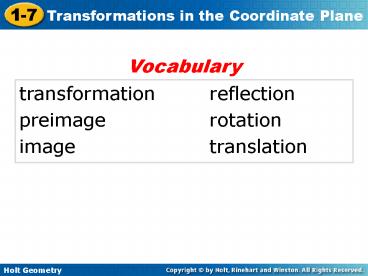transformation reflection - PowerPoint PPT Presentation
1 / 18
Title:
transformation reflection
Description:
A transformation is a change in the position, size, or shape of ... Write a rule for the translation of hexagon 1 to hexagon 2. A. A' Step 1 Choose two points. ... – PowerPoint PPT presentation
Number of Views:451
Avg rating:3.0/5.0
Title: transformation reflection
1
Vocabulary
transformation reflection preimage
rotation image translation
2
The Alhambra, a 13th-century palace in Grenada,
Spain, is famous for the geometric patterns that
cover its walls and floors. To create a variety
of designs, the builders based the patterns on
several different transformations.
A transformation is a change in the position,
size, or shape of a figure. The original figure
is called the preimage. The resulting figure is
called the image. A transformation maps the
preimage to the image. Arrow notation (?) is used
to describe a transformation, and primes () are
used to label the image.
3
(No Transcript)
4
(No Transcript)
5
Example 1A Identifying Transformation
Identify the transformation. Then use arrow
notation to describe the transformation.
The transformation cannot be a reflection because
each point and its image are not the same
distance from a line of reflection.
90 rotation, ?ABC ? ?ABC
6
Example 1B Identifying Transformation
Identify the transformation. Then use arrow
notation to describe the transformation.
The transformation cannot be a translation
because each point and its image are not in the
same relative position.
reflection, DEFG ? DEFG
7
Check It Out! Example 1
Identify each transformation. Then use arrow
notation to describe the transformation.
a.
b.
translation MNOP ? MNOP
rotation ?XYZ ? ?XYZ
8
Example 2 Drawing and Identifying Transformations
A figure has vertices at A(1, 1), B(2, 3), and
C(4, 2). After a transformation, the image of
the figure has vertices at A'(1, 1), B'(2, 3),
and C'(4, 2). Draw the preimage and image. Then
identify the transformation.
Plot the points. Then use a straightedge to
connect the vertices.
The transformation is a reflection across the
y-axis because each point and its image are the
same distance from the y-axis.
9
Check It Out! Example 2
A figure has vertices at E(2, 0), F(2, -1), G(5,
-1), and H(5, 0). After a transformation, the
image of the figure has vertices at E(0, 2),
F(1, 2), G(1, 5), and H(0, 5). Draw the
preimage and image. Then identify the
transformation.
Plot the points. Then use a straightedge to
connect the vertices.
The transformation is a 90 counterclockwise
rotation.
10
To find coordinates for the image of a figure in
a translation, add a to the x-coordinates of the
preimage and add b to the y-coordinates of the
preimage. Translations can also be described by a
rule such as (x, y) ? (x a, y b).
11
Example 3 Translations in the Coordinate Plane
Find the coordinates for the image of ?ABC after
the translation (x, y) ? (x 2, y - 1). Draw
the image.
Step 1 Find the coordinates of ?ABC. The
vertices of ?ABC are A(4, 2), B(3, 4), C(1, 1).
12
Example 3 Continued
Step 2 Apply the rule to find the vertices of the
image. A(4 2, 2 1) A(2, 1) B(3 2, 4
1) B(1, 3) C(1 2, 1 1) C(1, 0)
Step 3 Plot the points. Then finish drawing the
image by using a straightedge to connect the
vertices.
13
Check It Out! Example 3
Find the coordinates for the image of JKLM after
the translation (x, y) ? (x 2, y 4). Draw the
image.
Step 1 Find the coordinates of JKLM. The
vertices of JKLM are J(1, 1), K(3, 1), L(3, 4),
M(1, 4), .
14
Check It Out! Example 3 Continued
Step 2 Apply the rule to find the vertices of the
image. J(1 2, 1 4) J(1, 5) K(3 2, 1
4) K(1, 5) L(3 2, 4 4) L(1, 0) M(1
2, 4 4) M(1, 0)
Step 3 Plot the points. Then finish drawing the
image by using a straightedge to connect the
vertices.
15
Example 4 Art History Application
The figure shows part of a tile floor. Write a
rule for the translation of hexagon 1 to hexagon
2.
16
Example 4 Continued
The figure shows part of a tile floor. Write a
rule for the translation of hexagon 1 to hexagon
2.
17
Check It Out! Example 4
Use the diagram to write a rule for the
translation of square 1 to square 3.
Step 1 Choose two points. Choose a Point A on
the preimage and a corresponding Point A on the
image. A has coordinate (3, 1) and A has
coordinates (1, 3).
18
Check It Out! Example 4 Continued
Use the diagram to write a rule for the
translation of square 1 to square 3.
Step 2 Translate. To translate A to A, 4 units
are subtracted from the x-coordinate and 4
units are subtracted from the
y-coordinate. Therefore, the translation rule is
(x, y) ? (x 4, y 4).































